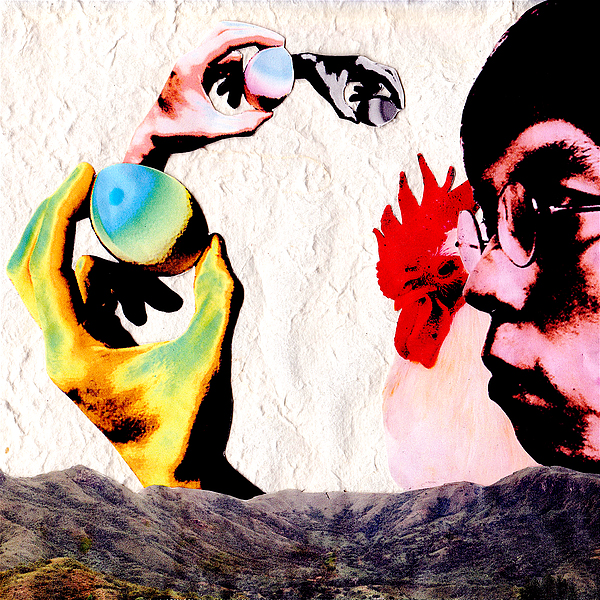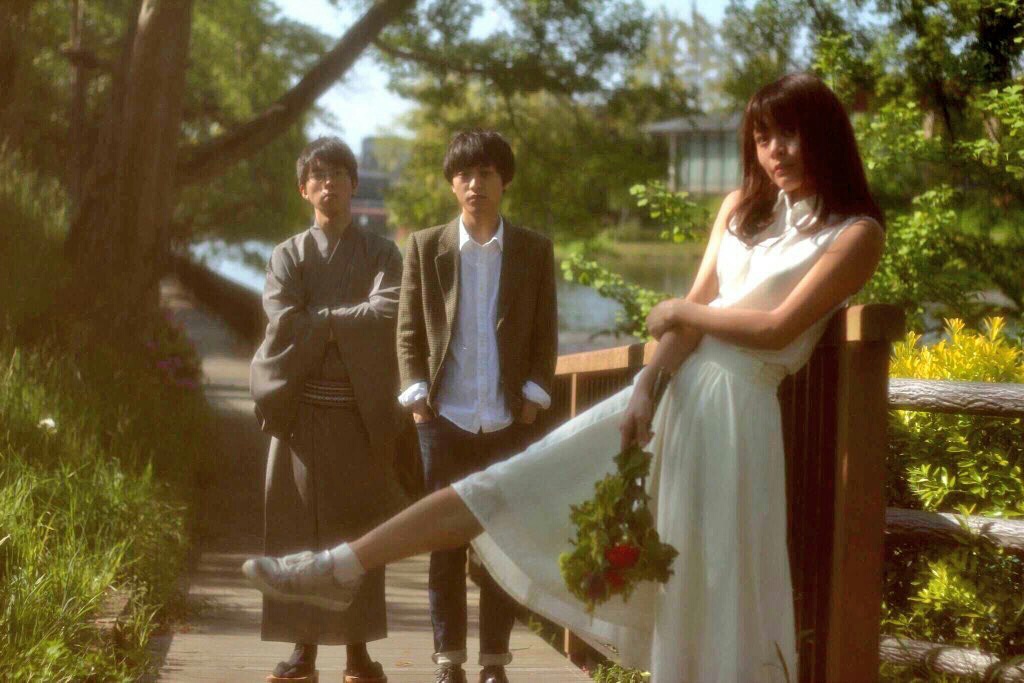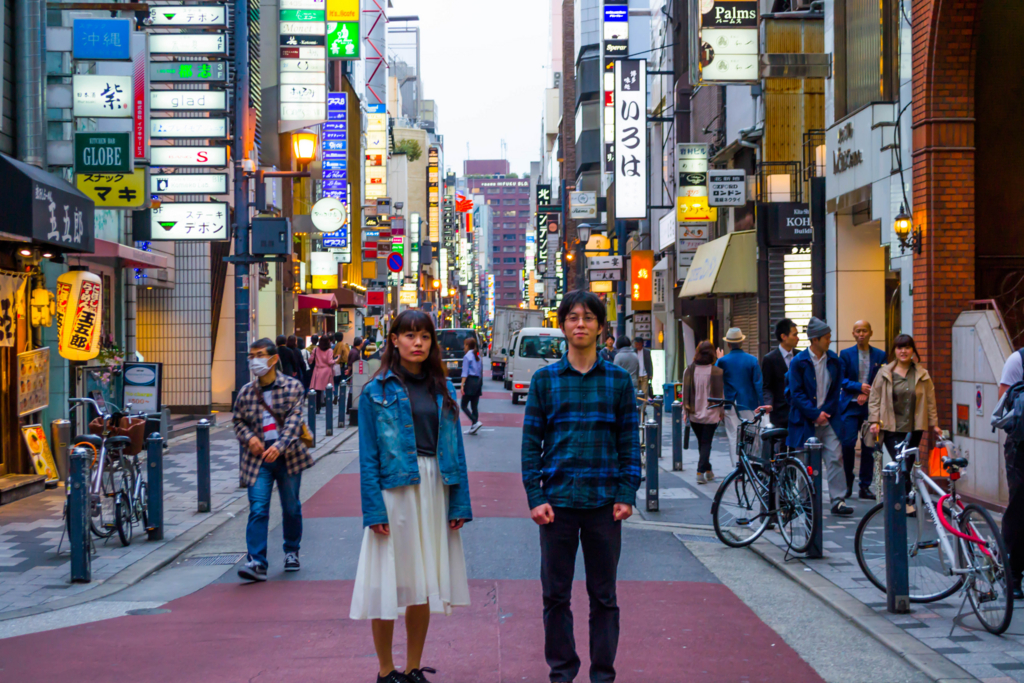Here is an interview with Oketa Tomomichi about his great debut album, Teiyuu Mokuroku. While at the time of this interview he was still a member of Uwanosora, he would go on to leave the band a couple of months later. Also featured on this album is Uwanosora vocalist Iemoto Megumi. Definitely do check out Oketa Tomomichi’s material if you have yet to do so.
Interview & text: Uchi Takahide of WebVANDA (Japanese text)
English translation: Henkka
Oketa Tomomichi on the web: Website, Twitter, Instagram, Bandcamp, YouTube
Note: You can buy Teiyuu Mokuroku from CDJapan.
As previously reported, Uwanosora member Oketa Tomomichi will be independently releasing his first solo album Teiyuu Mokuroku on May 31.
The programmed solo sounds heard on the album are the complete opposite of Uwanosora ’67, featuring band mates Iemoto Megumi and Kadoya Hirohide. With its very human, organic, 80s electro-pop sound, as someone who was listening to that very same sound in real-time back then there’s something quite nostalgic about this album. In today’s musical climate where everyone is eager to split everything up into sub-genres, leading to the undoing of more distinct trends in music, there’s something about the album that just sounds so fresh.
Beginning with the lead track “Channel No.1” with its striking combination of very visual lyrics and a groove unique to sequenced music, the songwriting and arranging on all of the album’s tracks was done solely by Oketa himself. Six out of the nine tracks feature Iemoto on vocals, while the other three — including “Channel No.1” — are sung by Oketa. Also featuring on “Channel No.1” as backing singers are two names not previously seen in the credits of other Uwanosora-related releases: Nakagaki Kazuyuki and Ura Atsushi.
With the album’s release fast approaching, we present to you an interview with Oketa Tomomichi.
— I’d like to start by asking about Uwanosora’s activities. Kadoya and Iemoto are doing Uwanosora ’67 while you are now doing this solo project. Could you give us your take as to how this came to be?
Oketa Tomomichi: Just as Kadoya said when the Uwanosora ’67 album was released, there was a difference of ideas. We started talking about our next release right after we’d done our first album, and Kadoya told us about his Uwanosora ’67 concept. I did think it was interesting an interesting idea, but we also felt like it was too soon for us to be making that the sound concept of the band’s next release. I myself was very much into Roger Nichols and other A&M stuff at the time, so we then thought it might be fun if the two of us took two different approaches, each with Iemoto on vocals.
While my initial concept for the project ultimately didn’t pan out, Uwanosora ’67 too was thought of entirely as a side project. So rather than trying to keep consistent with the sound concept or some-such, the basic idea was really just to present two different approaches. That was the main idea behind these side projects.
— I would have also liked to hear that Roger Nichols and A&M approach in your sound and compositions! Could you reveal what kinds of albums you were listening to around that time?
Oketa: The ’68 release Roger Nichols & The Small Circle of Friends obviously, but also Paul Williams‘ ’70 solo album Someday Man, and their demo compilation We’ve Only Just Begun. It’s something I’m still listening to all the time.
Besides them… It was pretty much inevitable that I’d also discover stuff like The Parade‘s Sunshine Girl, Harpers Bizarre‘s The Secret Life, and The Match’s A New Light. It was also right around this time that I bought Free Design‘s Kites Are Fun, You Could Be Born Again, and Heaven/Earth. And although they might be a little bit different in terms of direction, I was also constantly listening to Margo Guryan‘s Take a Picture and The Millennium‘s Begin.
As far as Japanese music, I was listening to stuff like Pizzicato Five‘s Couples and Cornelius‘ THE FIRST QUESTION AWARD — that is to say, “Shibuya-kei” with a Roger Nichols influence. And as they have Japanese lyrics, in a sense I was initially listening to them for guidance.
— You’ve just listed a number of amazing soft rock records. Did you get to hear Roger Nichols’ Treasury, his compilation from last year consisting of previously unreleased demos, music for commercials, and theme songs? There are some definite tips for composition hidden in there, so I feel like it might be essential listening for young songwriters such as yourself.
Oketa: I bought Treasury the day it was released. Talk about an invaluable album! It’s a great achievement by Roger Nichols of course, but also by Hamada Takayuki for making it happen. Once I become interested in the works of those sorts of songwriters-by-trade I want to learn everything there is to be learned about them, so I was especially anxious to hear disc two with the songs he’d written for commercials. (laughs)
— While it might be impatient of me to even ask… Now that you have both unveiled your side projects (or solo projects), is it safe to assume that you have started working on Uwanosora’s second album as well? Have you begun recording it yet?
Oketa: We’re taking things slow with Uwanosora itself. It’s a very “ebb and flow” kind of thing. Unfortunately I don’t have anything special to report to you about that right now, but we’ll do our best to be able to give you some news on that as soon as we can.
— Great. I’m very much looking forward to Uwanosora’s second album, too.
Oketa: Thank you. I’m happy to hear it.
— The sound and approach of your solo project is completely different from Uwanosora and, naturally, Uwanosora ’67. Would you say that this sort of a one-man operation with programmed sounds was in a way your original approach to making music?
Oketa: I do like programmed music, but of course I like other stuff, too. I like 70s sounding stuff, such as my songs on the first album and “Umbrella Walking,” but then I also like the 80s/90s sound that’s present on this project. I never felt that I had to try and stick to any particular style of music.
Rather than the style of music itself, I went the programming route because of how it’s made — quite simply, I enjoy layering sounds on top of sounds all by myself, and since it is released under my own name I wanted to try and do as much of it by myself as I could.
— You said you decided on this style due to how it’s made, but then one might also say that, for instance, the leading track “Channel No.1” with its unhurriedly resolving sequencer groove works as a song exactly because it’s programmed. Could you tell us what sequencers and software you used?
Oketa: That might be the case, yes. And not just “Channel No.1” either. For example, on “Riku no Kotou” — which takes a rather live-sounding approach in the scheme of this album — I’m doing this programmed rhythm pop thing in the background even there.
I did all the work in Logic Pro X. In the future though, I’d love to do stuff with an actual CR-78 or 808…
— On Uwanosora’s first album, you did all the songwriting on “Matenrou” and “Margaret,” and co-composed with Kadoya on “Sayonara Mugiwaraboushi” and “Koisuru Dress.” I wanted to ask on behalf of all Uwanosora fans… In the arrangement of “Matenrou,” I was told how things like the “Jolie-esque” organ solo and the obbligato were Kadoya’s ideas. So could you reveal to the extent that you can how arrangement is done in your band? Is it just… “Okay, so Oketa does this part and Kadoya this part“? (laughs)
Oketa: “Matenrou” is a song I wrote back in high school, and much of the arrangement was based on Kadoya’s ideas. The song’s length and that break in the interlude are as they were in the original arrangement though.
Although it wasn’t on the album, “Umbrella Walking” is similar in that sense. Kadoya did a good job in finishing this song of mine that I’d been kind of mulling over.
“Margaret” is my arrangement, and it’s also the only song where I’m playing the guitar myself… (laughs)
For “Sayonara Mugiwaraboushi,” I wrote the verse and Kadoya wrote the chorus. It was initially supposed to be this total ballad type of song, but at some point it had just morphed into what it became. (laughs)
And as for “Koisuru Dress,” that was actually a misprint in the credits! That song was in fact all Kadoya. Allow me to take this opportunity to set the record straight. (laughs)
— It’s interesting to hear those anecdotes regarding “Matenrou” and “Umbrella Walking.” So it’s like Kadoya, your bandmate of many years, kind of supported you in writing those songs. As for “Margaret,” I feel like the fleeting quality of the song almost makes it sound as if it could’ve been on this album.
And I’m surprised to hear how “Sayonara Mugiwaraboushi” was supposed to be a ballad. To me, it was the song with the most crossover elements of the whole album. Even the sax playing of Yamakami Hitomi — an old acquaintance of mine — has that kind of a taste to it.
Oketa: Kadoya took the lead when we were recording the songs, and while they did end up pointing towards the kind of sound I was aiming for, I gained so much insight that I wouldn’t have gotten had I been the one leading. It was very educational.
And about “Sayonara Mugiwaraboushi“… Well, we’d been talking about how we wanted an uptempo, cheerful song for the album. And yet I went ahead and wrote a ballad. (laughs) Yamakami gave us some great performances. We’re very grateful to her.
— The album’s title, Teiyuu Mokuroku (Fire Rooster Index) has that feel of classic literary works of ages past. What was the inspiration?
Oketa: Nothing in particular, but right around the time that I first started to think there was great significance in releasing something under my own name, I also felt that it was important for the release to happen in 2017. That’s why I wanted the title to start with “Fire Rooster” — seeing as it only comes around once every 60 years, I felt like it was now or never for this title. Had I missed my chance now, I would’ve had to wait until I was 86 years old to try again. (laughs)
— What with the average life expectancy only going higher and higher, you might well be able to release another album at 86. (laughs)
Oketa: One can only hope. (laughs) But in order to do that, everyone will first have to pick up this album so I can get started on the next one. Thank you for your co-operation. (laughs)
— What are some artists, albums, or songs that were an influence to you especially when writing the songs on this album?
Oketa: During the songwriting, I was mostly listening to the Moonriders‘ MANIA MANIERA, Aozora Hyakkei, ANIMAL INDEX, and Saigo no Bansan, Hirasawa Susumu‘s Jikuu no Mizu and Science no Yuurei, Pizzicato Five‘s Pizzicatomania, and — deriving from the aforementioned — stuff like Togawa Kyoko‘s Namida. Those albums are all very memorable to me not only in terms of their sound, but in terms of their lyrics, too.
— Oh, I see. Especially on “Channel No. 1” I could definitely hear a strong Moonriders influence of that period between their albums NOUVELLES VAGUES and MANIA MANIERA. As an aside, this one time I was with Kadoya at a bar where we had a music discussion that went on until dawn. When we got to talking about Moonriders, I guessed judging by his taste that “Shuumatsu no Koibito” (from the album Istanbul Mambo) was his favorite song by them. That Hirth Martinez-esque composition, the portamento-driven, decadent string arrangement, and that mellow sound… It’s just timeless.
Getting back to this album, the sound of “Osatou wo Sukoshi” is constructed in a way that is similar to the Moonriders’ “Sayonara wa Yoake no Yume ni” (from the album Istanbul Mambo), and Iemoto’s very touching vocals are reminiscent Onuki Taeko. Outside of the albums you mentioned, there were moments in there that reminded me of the Sakamoto Ryuichi-produced era of Onuki’s material. But then that might also be due to the color of Iemoto’s vocals.
Oketa: I strongly felt that I wanted to write a ballad like the Moonriders’ “Sayonara wa Yoake no Yume ni” or “Studio Musician” (from the album NOUVELLES VAGUES). I personally felt like the album wouldn’t have been complete without a song like that.
As for Onuki Taeko, I was also listening to her album cliché a lot. And if we go back all the way to SUGAR BABE, I have a feeling I was also very much influenced by the songs Onuki wrote for them. The track we were just talking about, “Margaret” from Uwanosora’s first album, that’s one I wrote in part with that mindset. I feel like these types of ballads suit Iemoto’s voice the best. In that sense, “Osatou wo Sukoshi” might be the “safest” song on this album.
— cliché is a great album. “Shikisai Toshi” especially is a song that will forever continue to stand the test of time. Ozawa Kenji — who just made a comeback this year — also paid homage to it with his song “Yubi Sae mo.”
Oketa: “Shikisai Toshi” is my absolute favorite song of Onuki Taeko’s works. I love listening to it alongside Yakushimaru Hiroko’s 1988 version. And I didn’t know “Yubi Sae mo” was an homage. Listening to it again now, it sounds so fresh.
— How long did the album take to write and record? Did you have any issues with it? Did anything interesting happen during the recording?
Oketa: It took from about June 2016 to March 2017. As it was mostly programmed, I was arranging and recording the songs as I wrote them. I feel like it took a relatively long time to make the album, but then again with a solo project like this there’s no one else there to influence you, for better or worse. So in hindsight it could’ve just as well have ended up taking even longer, or less.
As for recording troubles… I’m not sure if this counts, but this one winter evening as I got back from my part-time job and entered my room, this stray cat suddenly came running through between my legs. It seems it had somehow snuck inside the house, and since my room was the only one with the door left open, it had apparently settled in there. (laughs) I was chasing after it all over the house for over an hour before I managed to drive it out. Several times it made it into my room where it was causing havoc, and the entire time I was just begging it, “Please, not my computer! I’m working on something!” (laughs)
— While that is a very tranquil sort of anecdote one could never experience in the city, I must ask you to consider locking your doors and windows in the future — you’ve got important equipment in there! (laughs)
Oketa: Thank you for the advice. (laughs) I don’t have anything against cats, but seeing as I had to drive it out by force like that, I had to at least offer it some small consolation with that lyric at the end of “Osatou wo Sukoshi.” I don’t usually like explaining my lyrics, but that bit was something I couldn’t possibly have come up with had it not been for the cat, so… (laughs)
— I see, so that’s where the final stanza of “Osatou wo Sukoshi” came from. (laughs) “Mayoi neko oide / milk wo ageyou” (“come here, stray cat / lemme give you some milk“).
Oketa: It’s very time-consuming coming up with lyrics, so it was a chance for me to reflect once more on the value of these sorts of… stimulating life experiences. (laughs)
— Finally, please give us some words of self-promotion for this album.
Oketa: For now, I’m just relieved I’ve managed to get it released. (laughs) Compared to Uwanosora’s first album and the Uwanosora ’67 album which featured mainly live instruments, I hope listeners will enjoy hearing this music that sounds totally different.




